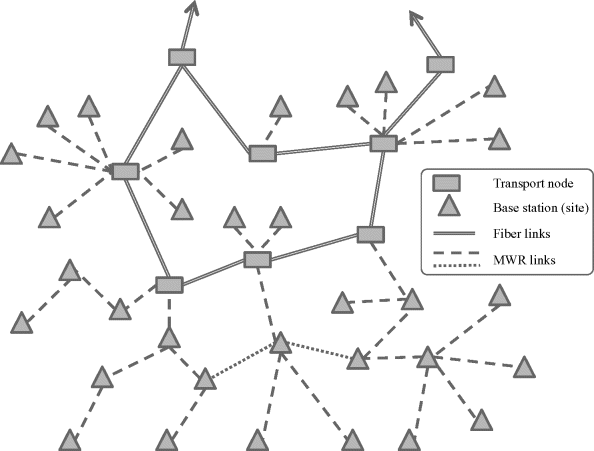2.2.1 Backhaul Basic Technologies
Most existing backhaul networks have been built to serve 2nd generation mobile networks (e.g. GSM or CDMA networks), or to serve combined 2nd and 3rd generation mobile networks (e.g. for the GSM and WCDMA networks in the same area). In addition there are a few backhaul networks serving just 3rd generation mobile networks.
These MBH networks are often built based on TDM transport technologies, i.e. mainly based on PDH and SDH/Sonet transport equipment, especially on lower tiers of the networks. Backhaul connections with these technologies are of fixed bandwidth, and they can be changed only by node reconfigurations locally or, with newer equipment, remotely by a network management system. Transport capacities in these networks are 1.5 or 2 Mbit/s or their multiples, 8 Mbit/s, 34 and 45 Mbit/s, and in upper tiers of the networks 155 Mbit/s and its multiples (620 Mbit/s, 2.5 Gbit/s etc) – the TDM bit rates are discussed in more detail in Chapter 05.
Some backhaul networks built specifically for 3rd generation mobile networks (WCDMA) also contain some ATM equipment e.g. for traffic concentration, especially on the aggregation and backbone network tiers. This equipment can improve capacity utilization efficiency compared to TDM, but on the other hand it adds another network layer to be managed and maintained, thus increasing network operational costs. ATM equipment has similar physical interfaces as PDH and SDH equipment (e.g. bit rates of 1.5 or 2, 34 or 45, and 155 and 620 Mbit/s).
More recently built or upgraded mobile backhaul networks also contain packet technologies, especially in the backbone tier and in the aggregation tier, but sometimes also in the access tier. Growing data traffic in mobile networks has increased the use of packet transport also in older backhaul networks, and in the near future growth of mobile data will make transition to the packet-based MBH networks necessary in many more mobile networks, if not in all of them, as will be discussed later in this chapter.
2.2.2 Backhaul Topology
As the 2nd and 3rd generation mobile networks do not have direct interconnections between the base stations, logical topology (traffic topology) of the backhaul transport networks is in these networks always a pure star: traffic goes directly from each base station to its controller.
Physical topology of a backhaul transport network usually is, however, very different – it is based on economic optimization of transport links and nodes as well as on the need to have resilience at least on the upper layers of the network. Physical topology is also very much the result of network history and gradual evolution, as with time more and more base station sites have been added to the network.
Figure 2.4 An example of MBH physical topology (access and lower aggregation tiers).

Often, the physical topology has tree and chain shapes near the base stations, as economy requires traffic concentration and minimization of the length of the individual (non-shared) access links. In upper network tiers the physical topology is based more on rings, as existence of alternative transport paths is here more important for the overall network resilience: failures affect a greater number of base stations. On upper tiers also the costs can be divided for a large number of base stations, making alternative routes economically more feasible. An example of MBH network physical topology (in the lower network tiers) is shown in Figure 2.4.
